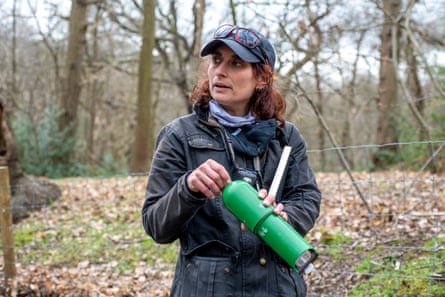It sounds like the alarm call of a macaque but is in fact the slowed-down squeak of a pygmy shrew. This warbling call is an insight into the hypersonic world of small mammals, which are generally very good at keeping their world secret from ours.
Ecologist Huma Pearce is listening to these unfamiliar woodland sounds on her laptop – but without a special device all she would hear would be the usual chatter of walkers, overexcited dogs and wind tickling the treetops.
“You’re hearing what you can hear, but sound goes above and beyond that,” says Pearce, who is tuning into the sounds of the small mammals inhabiting Lesnes Abbey Wood in south-east London, including the pygmy shrew, wood mouse, bank vole, common shrew and probably many more. “Once you start delving into the realm of high-frequency sounds, you soon realise that there is a lot more going on than what we can perceive without the aid of ultrasonic detectors.”
Sound above frequencies that humans can hear – around 20kHz – is considered ultrasound, and infrequent squeaks are often the lowest notes of complex hypersonic communication. Some house mice communicate with calls at up to 110kHz.
Mice, voles, rats, dormice and shrews all produce high-pitched sounds to attract partners, ward off potential threats, communicate within families and even find their way around using echo orientation, according to research published in British Wildlife magazine at the end of last year.

Pearce uses a bat detector to hear these small mammals. Their calls were initially seen as “by-catch” on bat detectors, and generally considered a bit of a problem. But five years ago, Stuart Newson from the British Trust for Ornithology (BTO) started tuning out of the bat noises and into mammal noises, most of which hadn’t been described before. “It was a bit of an eye-opener of how varied they are,” he says.
Newson started collecting a library of sounds and then built software that could identify them. Often sounds are quick, and it isn’t until they are slowed down that their complexity is revealed. He has been leading an 18-month project to create “acoustic classifiers” for small mammals for the first time.
Mammals produce a lot less sound than bats: a recorder left out for a week might have 800,000 bat calls and only 100 small mammal calls.
It is hard work picking out the calls. Dense vegetation distorts the sound waves reaching the microphone. Both humans and classifiers (which use algorithms) can struggle to detect calls when there is other noise around.
“If we were in a nightclub, and you’re over by the loos and I’m by the entrance, and you’re shouting at me, I can see that you’re trying to communicate something to me but I can’t make out what you’re saying because there is too much other noise around,” says Pearce. “This happens when doing recordings in woodland habitats. The goal is to design a methodology that will overcome these problems so that we collect the very best acoustic data.”

Researchers are in the process of creating an extensive library of sounds because hundreds, or even thousands, of recordings will be needed for the algorithm to work well.
In Lesnes Abbey Wood, Pearce has been using a bat detector called a Song Meter Mini, which costs £700 and can record constantly for three weeks using four AA batteries. She goes through the data picking out noise patterns that could come from small mammals, and compares these sounds to what she has caught in her human traps. Detectors can pick up calls from up to 10 metres away, depending on the animal.
For Ian Holt, estate manager at Lesnes Abbey Wood, this information is valuable because it helps him protect habitats, apply for grants and encourage more visitors. “The first thing to know is what you’ve got; if you don’t know what you’ve got you can’t manage it. Also if you want to impress upon people the importance of the wood, you can say, ‘we’ve got this, we’ve got that’,” he says.

The recent development of cheaper and improved bat detectors, such as £60 Audiomoth sensors, means there is a lot more sound data starting to come from landscapes. Most people extract bat calls from hypersonic recordings and dump the rest of it, says Pearce. “I’m now contacting bat groups and asking for their stationary acoustic data to try to find out how often and which species of small mammals are also recorded,” she says. Eventually Pearce wants to put acoustic recorders across London to build a complete map of small mammals in the capital.
At the moment it’s hard to monitor elusive small mammals without trapping them, and many landscapes are lacking data on small mammals. Acoustic identification could be an important non-interventionist way of recording their populations, which very often go undetected. Using acoustics could help monitor populations of rodents on seabird islands, for instance, which could then be followed up with more intensive surveying.
Newson has been contacted by people in other European countries who want to record mammals. “I think there could be benefits much more widely than the UK. I hope it will be a catalyst for people to think about acoustic potential,” he says. “I’m really confident the equipment will get cheaper, and as it becomes cheaper, it’ll become a lot more accessible.”
Find more age of extinction coverage here, and follow biodiversity reporters Phoebe Weston and Patrick Greenfield on Twitter for all the latest news and features
